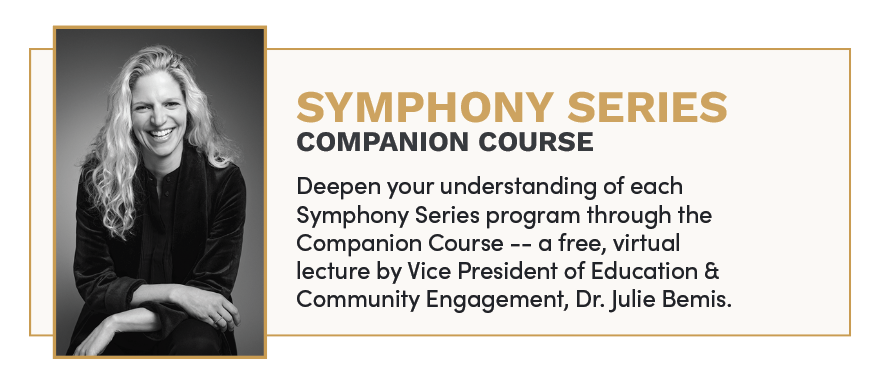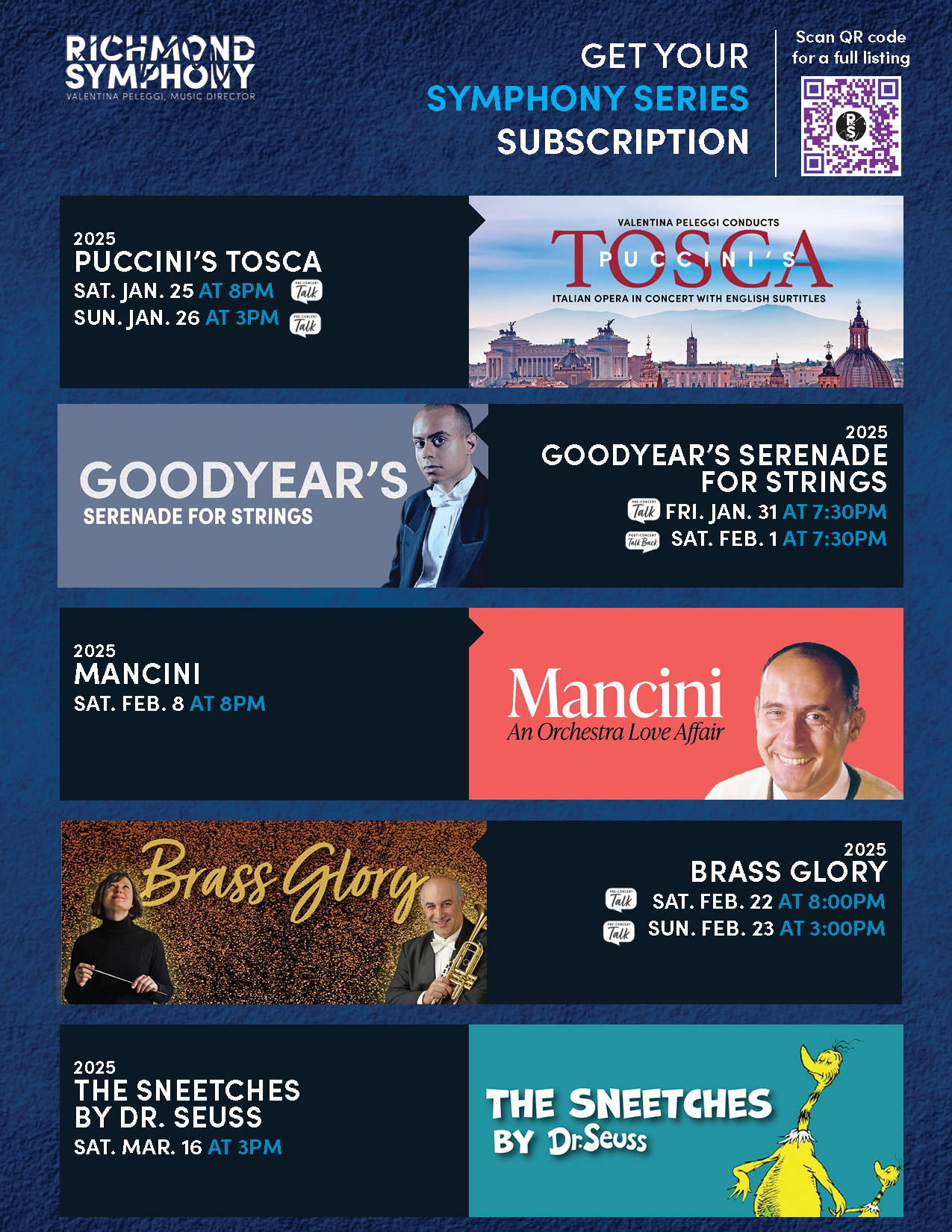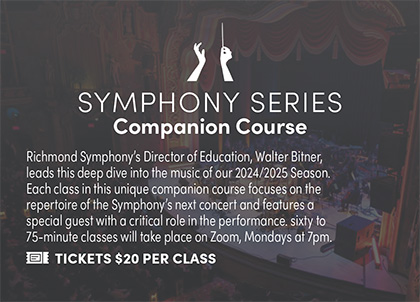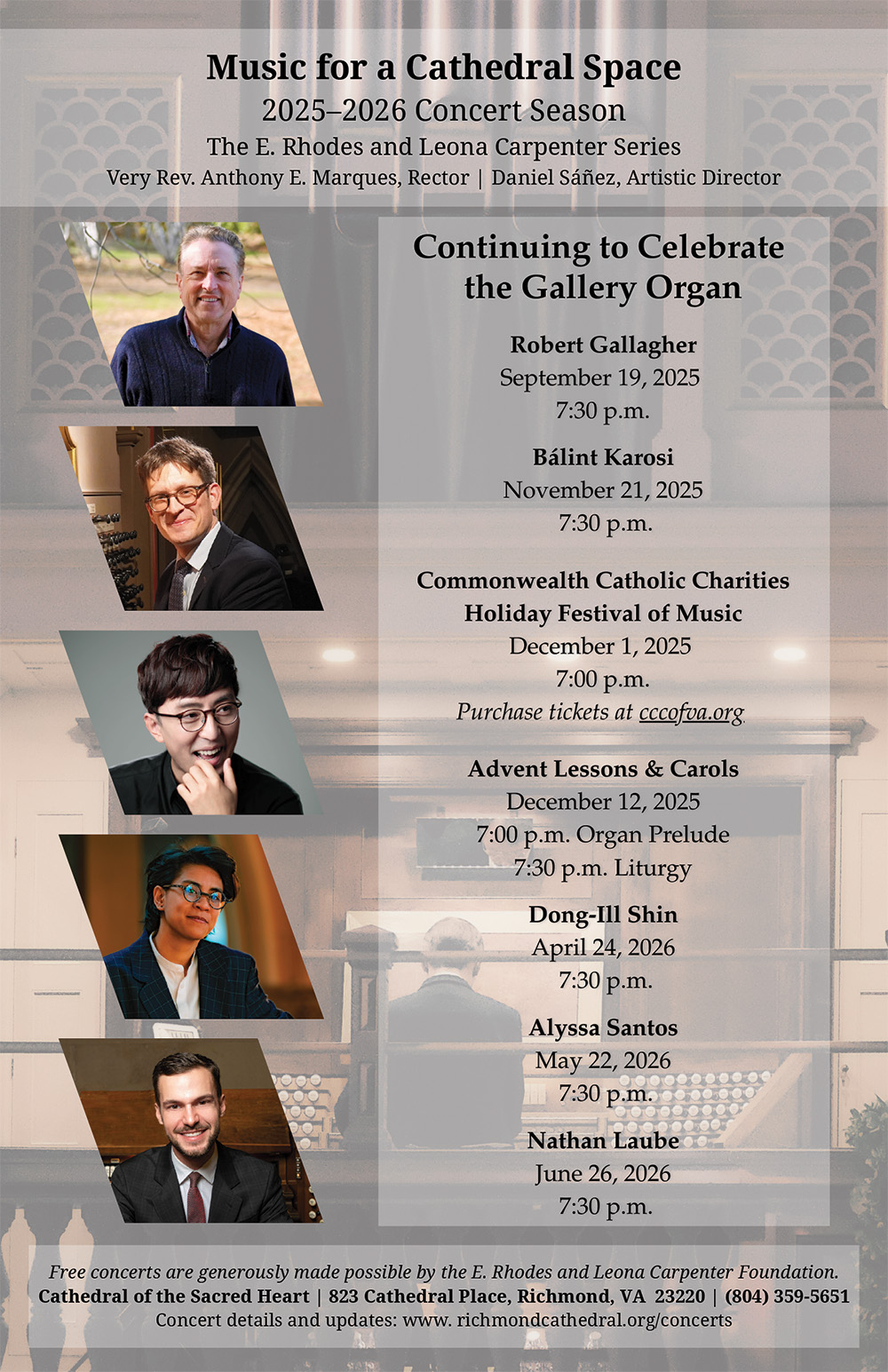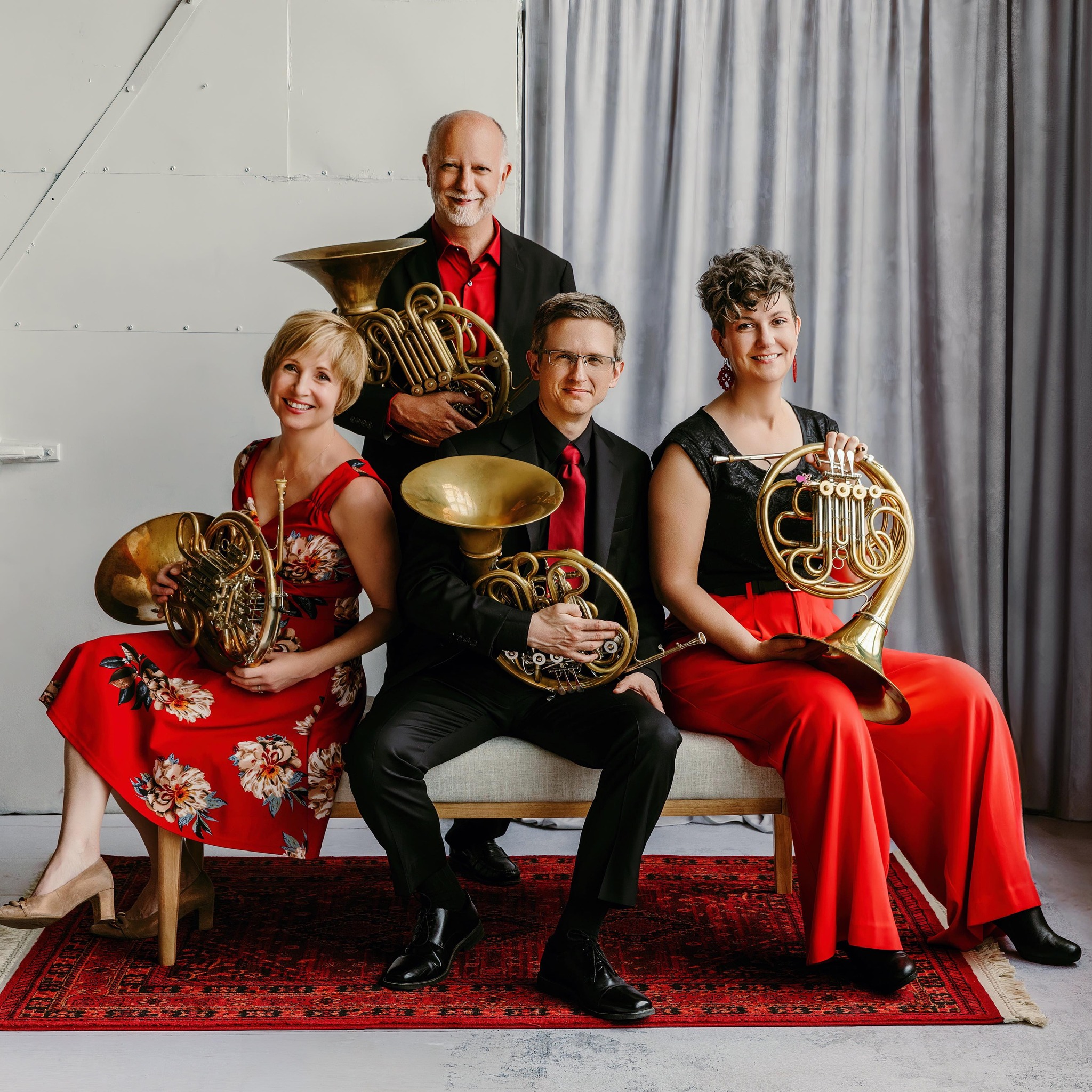
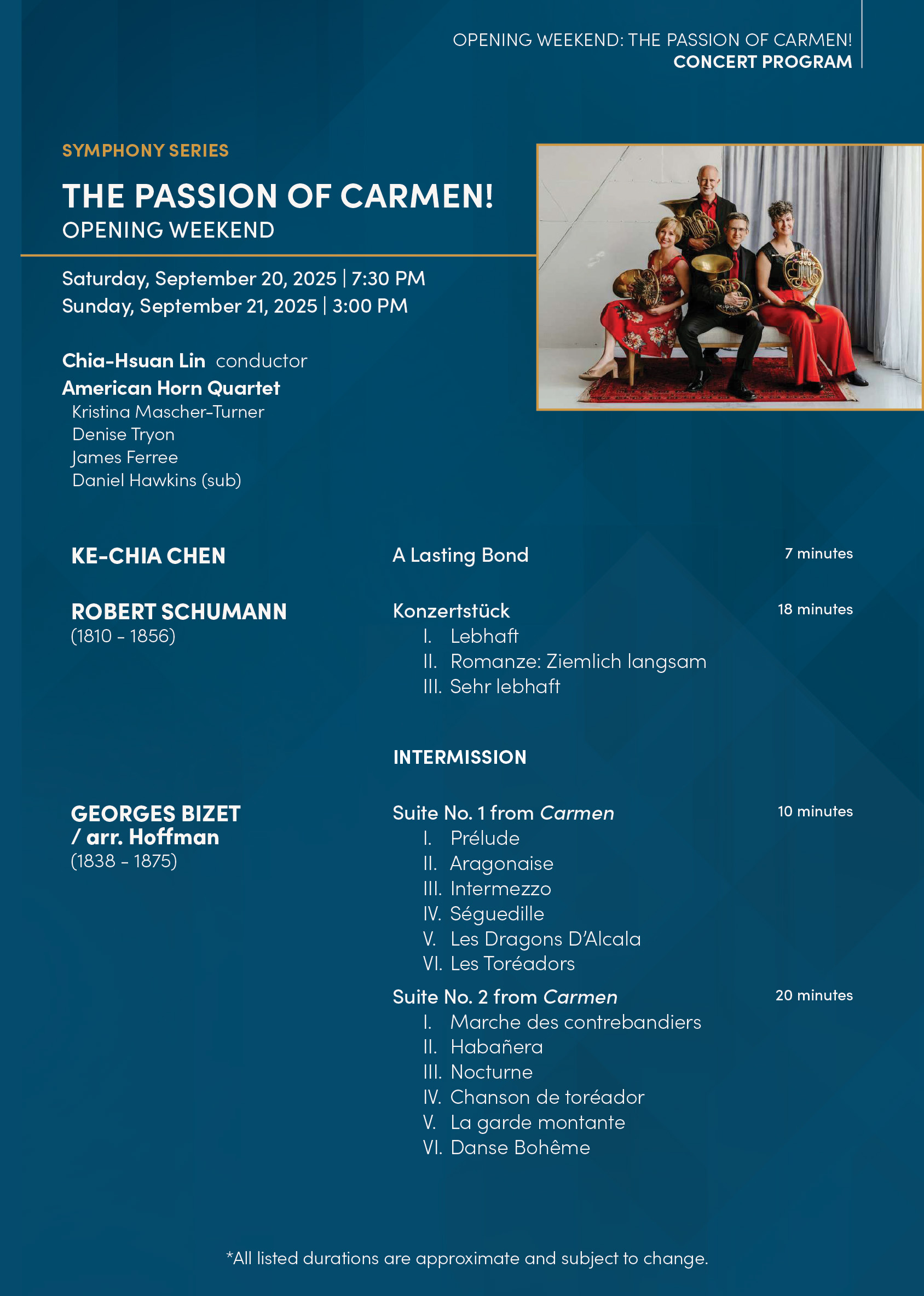
KE-CHIA CHEN: A Lasting Bond
ROBERT SCHUMANN: Konzertstück for four horns
GEORGES BIZET: Carmen Suites 1 and 2
This season opens under the baton of Chia-Hsuan Lin, who has been a vital part of the Richmond Symphony family since 2016, serving as Associate Conductor until the spring of 2024 and now in her second year as Principal Guest Conductor. For this program, she reunites onstage with the American Horn Quartet – a distinguished ensemble founded in 1982 that has become a global ambassador for horn repertoire. One of its newest members is James Ferree, familiar to audiences as former Principal Horn of the Richmond Symphony and now with the Baltimore Symphony Orchestra. Ferree and Lin are also married, making this shared appearance on the Richmond stage especially meaningful.
“Both are coming back to Richmond together on the same stage for this concert,” says Music Director Valentina Peleggi. “So we wanted to build a program around this bond – with each other, with the Richmond Symphony, and with our community.”
The Schumann Konzertstück, a unique concerto for four horns, places this heroic instrument at center stage. Framing it are two boldly expressive orchestral works: A Lasting Bond by Taiwanese composer Ke-Chia Chen and selections from Bizet’s Carmen – a score Lin is especially fond of, and one that offers the musicians a dazzling showcase of color and emotion. ho shares the composer’s heritage, has become a champion of her music.
Ke-Chia Chen: A Lasting Bond
Born in Taiwan and a member of the faculty at the Curtis Institute of Music since 2010, Ke-Chia Chen draws on both Asian and Western classical traditions to create a distinctive musical voice that speaks across cultures. Her music has been featured by such institutions and ensembles as Carnegie Hall, the Philadelphia Orchestra, the Indianapolis and Minnesota Orchestras, the Taiwan Philharmonic, and Copland House.
Composed in 2016, A Lasting Bond was heard in June of this year at Oregon’s Britt Music & Arts Festival, where it was conducted by Chia-Hsuan Lin, who shares the composer’s Taiwanese heritage. Lasting about seven minutes, the piece was inspired by the music and culture of the Saisiyat people, one of the smallest Indigenous groups in Taiwan. The Saisiyat live primarily in the mountainous regions of Hsinchu and Miaoli counties and are known for their oral traditions, animist beliefs, and the ceremonial rituals through which they preserve their heritage.
Despite generations of outside pressure – from colonial forces and competing communities – the Saisiyat have maintained a strong cultural identity, using folksong “to pass on their traditional values to the next generation,” the composer notes. “These folksongs have not only become a great vehicle to remind the younger Saisiyat of their ancestral wisdom and heritage, but also a way for other cultures to understand their society.”
Chen incorporates and transforms fragments from two traditional Saisiyat melodies – Hunting Song and Song of Fear – which she describes as “very representative of the pride and steadfastness of the Saisiyat.” By reimagining their musical language in an orchestral setting, A Lasting Bond becomes a gesture of artistic solidarity across generations and cultures.
Robert Schumann: Konzertstück for Four Horns in F major, Op. 86
“The horn is the soul of the orchestra,” Robert Schumann once declared – a sentiment that resonates deeply with the Romantic imagination. From the forests of Carl Maria von Weber’s Der Freischütz to the heroic calls of Richard Wagner’s operas, the horn had evolved from its associations with hunting and came to symbolize the untamed spirit of nature, as well as a kind of idealistic longing for the unattainable.
In Schumann’s time, the instrument was undergoing a dramatic transformation. The mid-19th century brought significant advances in brass metallurgy and technology, including the introduction of valves, which greatly expanded the horn’s agility and range. Fascinated by this new horn, Schumann was eager to explore its expressive possibilities.
He composed the Konzertstück within a mere few days in February 1849, while living in Dresden. The city simmered with revolutionary fervor at the time. Schumann’s contemporary Richard Wagner was soon to be dismissed from his post as music director of the city’s opera for his participation in the May Uprising in Dresden, and would be forced to flee into exile from German territory.
Schumann tended to steer clear of direct political engagement, but his fascination with musical revolution was channeled into sound. In this work, he seized upon recent innovations in brass technology: the valved horn, newly refined in the 1830s and still considered cutting-edge in the 1840s. These technical advances enabled greater range, flexibility, and virtuosity – all qualities that Schumann explores in the Konzertstück. The composer described the piece to his publisher as “something quite curious” and held it in particularly high regard, calling it “one of my best.”
Though the Konzertstück resembles a concerto in form and scope, Schumann’s unusual title – German for “concert piece” but also implying “concerto piece” – suggests something looser and even more theatrical than a traditional concerto. In fact, the term Konzertstück had been used before by Weber for his 1821 concert piece for piano and orchestra, for which he conjured a dramatic program involving a noblewoman awaiting the return of her knight from the Crusades.
Schumann offers no explicit narrative beyond voicing the soul of the horn. Rather than feature a single soloist, he elevates four horn players to equal prominence, akin to a dramatic ensemble cast as opposed to a single protagonist with accompaniment. Or better: the idea of the horn itself plays the hero. The title also signals that classical formality is not the point – and certainly not to be expected.
Konzertstück condenses the conventional three movements concerto design (fast–slow–fast) into a single, continuous span. The energetic opening part includes bright fanfares, syncopated rhythms, and a galloping momentum that highlights the horns’ associations with heroism and war. The music transitions seamlessly into the central “Romanze,” a lyrical and intimate episode that brings out the horn’s soulful, poetic voice. The instrument’s Romantic mystique comes especially to the fore in this tender, introspective interlude.
The lively final section bursts back into motion with renewed vigor. A sense of camaraderie but also, perhaps, competition builds among the soloists as Schumann ratchets up the virtuosity. The Konzertstück ends in a blaze of color and fireworks.
Georges Bizet: Carmen Suites 1 and 2
Today, Carmen stands as one of the most familiar and beloved icons of classical music and opera – yet its composer never lived to enjoy the success of his creation. Georges Bizet died on June 3, 1875, exactly three months after the opera’s premiere, unaware of how far-reaching its impact would be. How could he have imagined that the opera would go on to become one of the most performed works in the repertoire, with its melodies quoted in cartoons, commercials, pop songs, and film scores? (Think Jonathan Larson, whose untimely death preceded the breakthrough of Rent.)
The image of Carmen herself – the bold, free-spirited woman who refuses to be controlled – has become an enduring symbol in popular culture. Over the decades, the opera has inspired countless reinterpretations across theater, dance, and cinema, from ballets to jazz arrangements to Hollywood adaptations – even Carmen on Ice, a full-length figure skating. What began as a controversial work in the turbulent Paris of the 1870s would eventually shape how the world imagines operatic passion and fatal attraction.
Bizet had based the opera on Prosper Mérimée’s novella from 1845 – a gamble in itself, centered on a free-spirited woman destroyed by her possessive lover. Though often seen as the quintessential “Spanish” opera, Carmen may in fact have Russian roots: Mérimée, a translator of Russian literature, likely drew inspiration from Pushkin’s narrative poem The Gypsies. And while Bizet infused the score with evocative Spanish color, he never actually visited Seville, where the story is set.
The fiercely independent Carmen, who works in a cigarette factory in Seville, captivates the soldier Don José. Blinded by obsession, he abandons his duty and honor for Carmen – only to be cast aside when she falls for the glamorous bullfighter Escamillo, leading to a fatal final confrontation with the jealous Don José.
But Carmen’s ascent to fame was anything but immediate. Its premiere wasn’t a total fiasco – the first production ran for a respectable number of performances – but audiences were unsettled by its unprecedented realism and depiction of obsessive passion and violence emotions. In the wake of Bizet’s premature death, his friend Ernest Guiraud stepped in to help secure the opera’s future. He replaced the original spoken dialogue with sung recitatives, making the opera more favorable to being staged internationally.
Guiraud also assembled two orchestral suites drawn from Carmen’s most evocative music. These concert suites (each comprises six selections) helped ensure the music’s life beyond the theater. Though originally published in a fixed order, the pieces are often reshuffled in performance, with conductors choosing a sequence that mirrors the opera’s dramatic arc or highlights particular contrasts in mood and character.
Across both suites, Bizet’s gift for vivid orchestration and theatrical intensity is on full display. Suite No. 1 includes the darkly dramatic Prelude with its trembling strings and ominous Fate motif; the fiery Aragonaise, which sets the stage for the bullfight; and the flute-sweetened Intermezzo, shifting the scene to the mountains outside Seville. The sensual Seguidilla is transformed from Carmen’s flirtatious solo into a seductive instrumental dance, while the swaggering Marche du Toréador serves as the toreador Escamillo’s musical calling card – and also underscores Carmen’s defiance as her fate closes in at the end.
Suite No. 2 includes the opera’s most famous tune, the Habanera, in which Carmen lays out her philosophy of love as a force that comes and goes as it pleases. The gentle Nocturne, drawn from the music associated with Micaëla – a devout young woman who loves Don José – offers a refuge of tender lyricism, while the March of the Smugglers adds a dash of stealthy, suspenseful rhythm. The dance performed by Carmen and her companions at the smugglers’ hangout builds thrilling momentum and culminates in a burst of unleashed, frenzied energy.
Even without singers, the music from Carmen is packed with drama and dazzling instrumental color – an electrifying curtain raiser to open the Richmond Symphony’s new season.
Program notes (c)2025 Thomas May
This season opens under the baton of Chia-Hsuan Lin, who has been a vital part of the Richmond Symphony family since 2016. For this program, she reunites with the American Horn Quartet – a distinguished ensemble founded in 1982 that has become a global ambassador for horn repertoire. One of its newest members is James Ferree, former Principal Horn of the Richmond Symphony and now with the Baltimore Symphony Orchestra. Ferree and Lin are also married, making this shared appearance on the Richmond stage especially meaningful.
“Both are coming back to Richmond together on the same stage for this concert,” says Music Director Valentina Peleggi. “So we wanted to build a program around this bond – with each other, with the Richmond Symphony, and with our community.”
The Schumann Konzertstück, a unique concerto for four horns, places this heroic instrument at center stage. Framing it are two boldly expressive orchestral works: A Lasting Bond by Taiwanese composer Ke-Chia Chen and selections from Bizet’s Carmen – a score Lin is especially fond of, and one that offers the musicians a dazzling showcase of color and emotion.
Ke-Chia Chen / A Lasting Bond
Born in Taiwan and on faculty at the Curtis Institute of Music since 2010, Ke-Chia Chen draws on both Asian and Western classical traditions to create a distinctive voice. She composed A Lasting Bond in 2016, inspired by the music of the Saisiyat people, one of Taiwan’s smallest Indigenous groups. Known for their oral traditions and animist beliefs, the Saisiyat use ceremonial folksong to preserve and transmit their heritage.
Despite centuries of outside pressure, the Saisiyat have maintained a strong cultural identity. Chen notes how their folksongs serve as a vehicle for transmitting ancestral wisdom, not only within the community but across cultures. She incorporates two traditional melodies – Hunting Song and Song of Fear – which Chen describes as “representative of the pride and steadfastness of the Saisiyat.”
Robert Schumann / Konzertstück for Four Horns in F major, Op. 86
“The horn is the soul of the orchestra,” Robert Schumann once declared. In the
Romantic imagination, the horn evoked nature, heroism, and noble longing. By the mid- 19th century, the instrument was undergoing a dramatic transformation. Advances in brass technology, including the introduction of valves, greatly expanded the horn’s range and agility – qualities that fascinated Schumann and shaped his Konzertstück, composed in just a few days in February 1849.
Schumann lived in Dresden, then simmering with revolutionary energy. While he himself avoided direct political action, his music embraced innovation. He described the Konzertstück to his publisher as “something quite curious” and considered it “one of
my Best.”
Though resembling a concerto, the piece is more theatrical and ensemble-driven. Schumann doesn’t feature a single soloist but elevates all four horn players, treating them as a dramatic ensemble. The horn itself becomes the hero.
The work compresses the traditional fast–slow–fast concerto structure into a continuous sweep. It opens with bright fanfares, syncopated rhythms, and galloping energy; then moves into a lyrical “Romanze,” bringing out the horn’s soulful, poetic voice. The final section bursts forth with dazzling virtuosity, closing in a blaze of color and fireworks.
GEORGES BIZET / Carmen Suites 1 and 2
Today, Carmen stands as one of the most beloved icons of classical music and opera – yet Bizet never lived to enjoy its success. He died in 1875, three months after the premiere, unaware of how far-reaching its legacy would become. Carmen’s melodies have since echoed in cartoons, commercials, pop songs, and film scores.
Carmen herself – the bold, free-spirited woman who refuses to be controlled – has become a cultural symbol, inspiring countless reinterpretations in theater, dance, and cinema. Bizet based the opera on Prosper Mérimée’s 1845 novella, centered on a free- spirited woman destroyed by her possessive lover. Curiously, Bizet himself never traveled to Spain, let alone Seville, where the story is set.
Carmen, a cigarette factory worker in Seville, captivates the soldier Don José. Blinded by obsession, he abandons his duty and is cast aside when she falls for the bullfighter Escamillo – leading to a fatal final confrontation.
Carmen’s path to fame was anything but smooth. The premiere was not a disaster, but audiences were unsettled by its realism and emotional volatility. After Bizet’s death, his friend Ernest Guiraud assembled two orchestral suites from Carmen’s most evocative music. Though originally published in a fixed order, these selections are often reshuffled to reflect the opera’s dramatic arc. Together, the suites capture the opera’s vivid orchestration and
theatrical flair.
Suite No. 1 includes the darkly dramatic Prelude with its trembling strings and Fate motif; the fiery Aragonaise; the flute-sweetened Intermezzo; the sensual Seguidilla, transformed into a seductive instrumental dance; and the swaggering Marche du Toréador, Escamillo’s musical emblem.
Suite No. 2 features the famous Habanera, where Carmen declares love as a fickle force. The gentle Nocturne, based on music for Micaëla, offers tender lyricism; the March of the Smugglers adds stealthy, suspenseful rhythm. The Danse Bohème, performed by Carmen and her companions, builds thrilling momentum and ends in a burst of unleashed, frenzied energy.
Program notes (c)2025 Thomas May
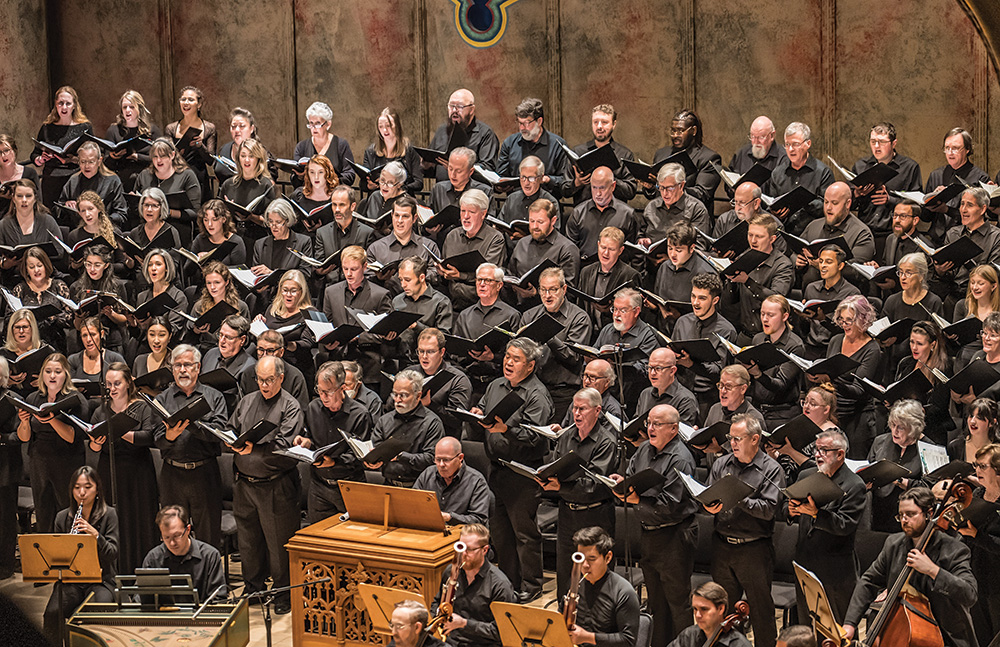
The Richmond Symphony Chorus is an award-winning ensemble of 150 members from the Richmond region. The chorus performs regularly with the Richmond Symphony, Richmond Ballet, and in stand-alone performances around the community. Its members are a diverse group of Richmond community members united by a shared passion for
choral singing.
Founded by James Erb in 1971 to perform Beethoven’s Missa Solemnis under the baton of renowned conductor Robert Shaw, the Richmond Symphony Chorus has a rich history. Erb, a professor at the University of Richmond and a renowned scholar of choral music, led the group for 36 years. Conductor Erin Freeman led the chorus from 2007 to 2021, directing performances in Richmond, Wintergreen, Carnegie Hall, and Paris, France. In 2018, the Chorus was featured in the GRAMMY®-nominated recording of the premier performance of “Children of Adam” by American composer Mason Bates and Vaughan Williams’ Dona Nobis Pacem. Over the years, the chorus’s repertoire has featured classic masterworks, numerous contemporary compositions and premieres, and symphonic pops performances.
Following his appointment as Artistic Director in the spring of 2024, Richard W. Robbins has led the Richmond Symphony Chorus into its 54th season, bringing a fresh and innovative vision to its programming. His inaugural performance on the Carpenter Theatre stage, in June 2024, featured a powerful rendition of Verdi’s Requiem, conducted by our Music Director, Valentina Peleggi. This 2025-26 season, under Richard’s direction, the chorus showcases its artistry in a diverse range of programs, from Zachary Wadsworth’s Letter to the City to the festive American Choral Classics. Upcoming performances include Damien Geter’s An African American Requiem and Holst’s The Planets, further exemplifying the chorus's continued commitment to excellence and artistic exploration.
Richard W. Robbins | CHORUS DIRECTOR
JAMES ERB CHORAL CHAIR
Kevin L. Barger | ASSISTANT CHORUS DIRECTOR
Daniel Stipe | REHEARSAL ACCOMPANIST
Janice Guzman | CHORUS MANAGER
Barbara C. Batson, Carl J. Eng, and Lisa C. Fusco | REHEARSAL ASSISTANTS
soprano | Elizabeth S. Miller |
